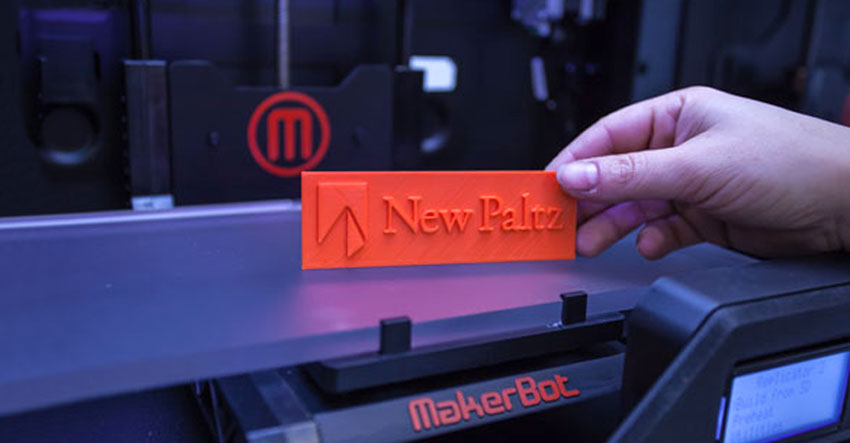
3D printing is taking the world by storm. In the last year, we’ve been introduced to a wide range of uses and impact this technology can provide us, from building a prosthesis hand for a 7-year old boy to finding ways to build implantable tissues and organs to fight disease. These innovative breakthroughs show how 3D printing fosters an entrepreneurial spirit and the potential to create new jobs in New York and beyond with commercial partnerships like the Hudson Valley Advanced Manufacturing Center at SUNY New Paltz.
Two years ago, SUNY New Paltz, Hudson River Ventures, Central Hudson and the Hudson Valley Economic Development Corporation announced the formation of the Hudson Valley Advanced Manufacturing Center (HVAMC) at SUNY New Paltz, along with the innovative Digital Design and Fabrication (DDF) certificate program. Since then the College has created a comprehensive set of programs, including establishing a MakerBot Innovation Center, which have positioned SUNY New Paltz as a national model in the innovative use of 3D printing.
Comprehensive colleges like SUNY New Paltz have a clear mission of providing a high quality education that is affordable, a mission that requires a great deal of focus and does not leave many resources for responding to new opportunities and challenges. Moreover, academic institutions are not known for being nimble and innovative in response to trends. These factors make what has happened at our college a story worth telling.
Over 1 year ago SUNY @newpaltz opened its #MakerBot Innovation Center. The results? #Amazing. http://t.co/J0OG3TGnz3 pic.twitter.com/CGJJC9X7B9
— MakerBot (@makerbot) May 28, 2015
The Beginning
It all began when faculty in the Schools of Fine and Performing Arts and Science and Engineering were investigating possible interdisciplinary programs. The group noted that the objectives and rules we work by can be different, but the mindset to create new things and work in the physical world give these fields a common language and a basis for cooperative learning. New Paltz had expertise in 3D printing in the Art Department and interest among faculty in computer science and engineering. 3D was a natural fit.
Simultaneously, Hudson River Ventures and Central Hudson had each committed to $250,000 in funding that would allow the College to purchase industry-scale 3D printers. With guidance from Hudson Valley Economic Development Corporation, the effort to fuse learning and manufacturing, science and the arts came to fruition with the launch of the Hudson Valley Advanced Manufacturing Center in Spring 2013.
@SUNY New Paltz #3Dprinting initiative wins $1 million in state economic development funding. http://t.co/1xsLrjpeC5 #HudsonValley #HVAMC
— SUNY New Paltz (@newpaltz) December 11, 2013
The initiative continued to gain momentum and in February 2014, the College partnered with Brooklyn, N.Y. – based MakerBot, the leading manufacturer of desktop 3D printers, to open the nation’s first MakerBot Innovation Center at SUNY New Paltz. We immediately recognized this as a great opportunity as we had run into a problem—3D printing is addictive and slow. Once you realize its potential, you want to use it for various applications and offer it to as many folks as possible, particularly in introductory courses. Currently, the Center functions as a 3D printing service center for the campus and, through the HVAMC, for the entire region.
To date, the HVAMC is providing digital design and fabrication expertise to about 70 businesses and entrepreneurs throughout the region. Additionally, the College graduated the second class of DDF students, drawing a diverse and talented group of students from the professional worlds of art, design and engineering. Within SUNY New Paltz, the collaboration has broadened beyond the Schools of Fine and Performing Arts and Science and Engineering to include the Schools of Education and Business. Workshops and courses for K-12 educators, including through the Governor’s New York State Master Teachers Program, have attracted a wide variety of teachers, from art to science, who have an interest in digital design and fabrication and are utilizing these new technologies in their classrooms.
I still say we are just getting started.


